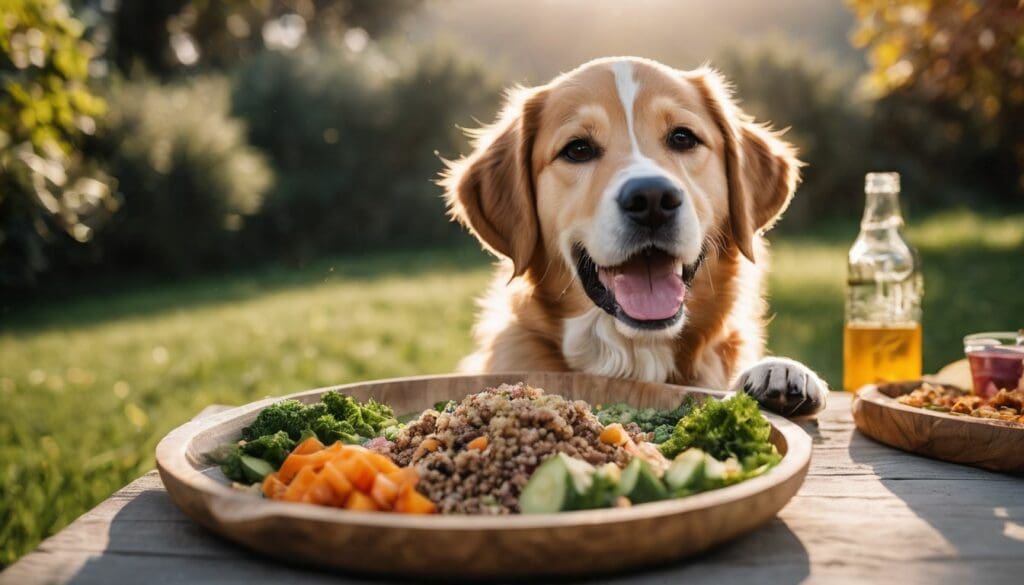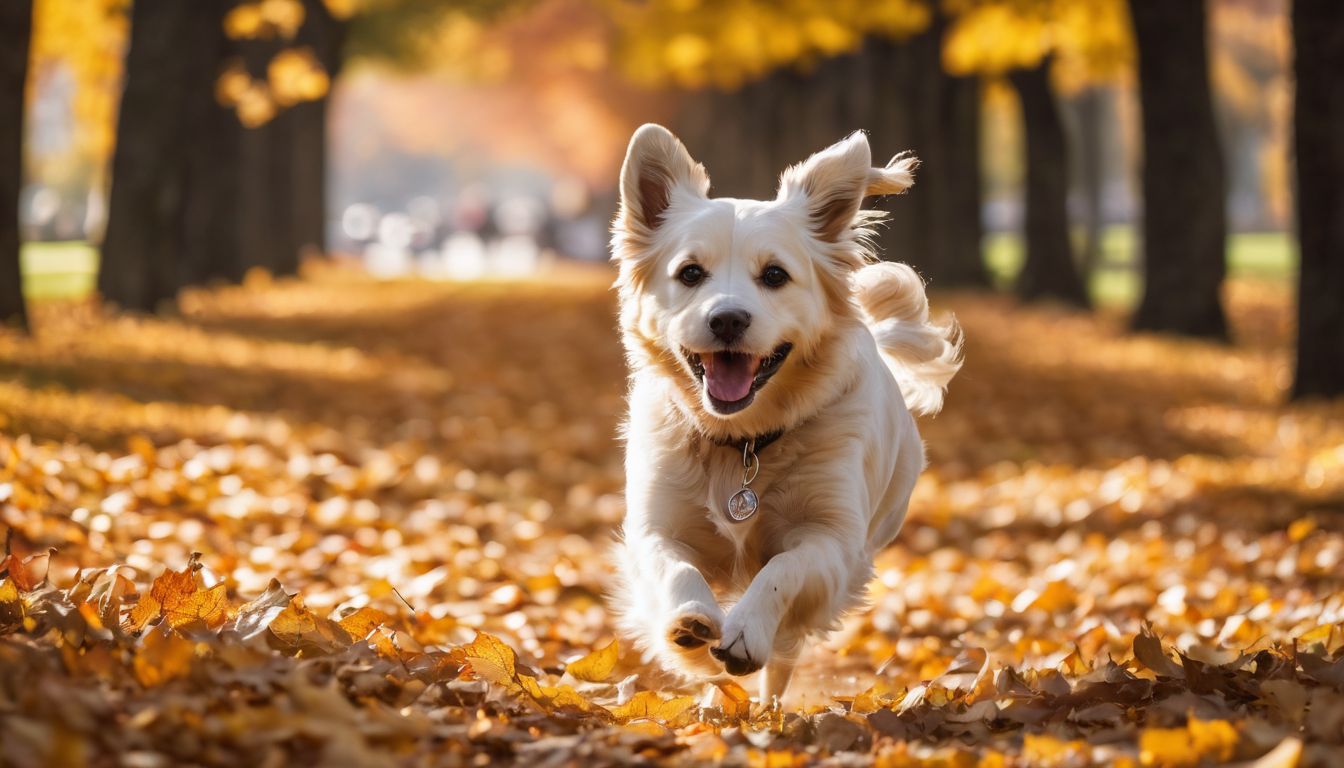Are you pondering how to boost your furry friend’s health and vitality? Around 60% of pet owners feel their pet’s diet directly affects their well-being. This article unveils the remarkable benefits a raw diet can offer your pets, from shinier coats to improved digestion.
Let’s dig in for their ultimate health transformation!
Key Takeaways
- Raw diets for pets include natural ingredients like raw meat, bones, and vegetables and aim to mimic the diet of wild animals.
- Pet owners report benefits such as stronger immune systems, better digestion, healthier skin and coat, higher energy levels, improved oral health, and smaller stools after their pets switch to a raw diet.
- It’s crucial to consult with a veterinarian before transitioning your pet to a raw diet due to potential risks like bacterial contamination and nutritional imbalances.
- Preparing a balanced raw diet requires careful planning and an understanding of individual pet needs based on breed size, age, activity level, and health conditions.
- While some veterinarians advocate for the benefits of raw diets based on ancestral habits and natural digestive systems, others highlight concerns over health risks; therefore, personal research alongside professional advice is key.
What is a Raw Diet for Pets?
A raw diet for pets consists of uncooked, natural ingredients such as raw meat, bones, fruits, and vegetables. It is a form of feeding that aims to replicate the diet of wild animals and provide essential nutrients for overall health.
Definition and explanation
Raw diets for pets typically include ingredients like uncooked meat, bones, fruits, and vegetables. This approach to feeding is based on the belief that a natural diet resembling what animals eat in the wild contributes positively to their health.
Advocates suggest that this type of diet aligns with an animal’s evolutionary nutrition and can lead to multiple health benefits.
Types of raw food diets vary widely but often encompass commercially prepared formulas as well as home-prepared meals adhering to specific recipes recommended by canine nutrition experts.
These feedings may be tailored specifically for dogs or other pets based on their nutritional needs and any specific health concerns they might have. Transitioning pets to this kind of diet should always be done thoughtfully, considering all safety aspects regarding preparation and handling of raw food to ensure optimal benefits for pet health.
Types of raw diets for pets
Raw diets for pets come in various forms, each offering unique nutritional benefits and considerations. Here are the types of raw diets commonly considered for pets:
- Whole Prey Diet: This diet includes feeding whole small animals or prey to your pet, mimicking their natural diet in the wild.
- BARF Diet (Biologically Appropriate Raw Food): This diet consists of raw muscle meat, bones, organs, fruits, and vegetables to provide a balanced nutritional intake.
- Homemade Raw Diet: Pet owners prepare this diet at home using raw ingredients such as meat, organs, eggs, and small amounts of fruits and vegetables based on specific recipes and guidelines.
- Pre-Made Commercial Raw Diets: These include commercially prepared raw food options specifically formulated to meet the nutritional needs of pets. They often come in frozen or freeze-dried forms.
- Frankenstein Diet: It involves combining pre-made raw food with other dietary elements such as kibble or cooked food to create a mixed feeding approach.
- Vegetarian Raw Diet: Although less common for dogs due to their carnivorous nature, some pet owners opt for a vegetarian raw diet that includes plant-based alternatives rich in protein sources like legumes and soya products.
- Gently Cooked Diets: While not entirely “raw,” these diets involve gently cooking foods at low temperatures to preserve essential nutrients while reducing bacteria risks.
The Potential Benefits of Raw Diets for Pets
Raw diets for pets can provide a range of benefits, including a stronger immune system, improved digestion, better oral health, healthier skin and coat, increased energy levels, and smaller stools.
These natural diets offer an alternative to commercially processed pet food and may contribute to overall canine health.
Stronger immune system
A raw diet for pets can contribute to a stronger immune system, supporting their overall health and well-being. Natural pet food, including raw meat diets for pets, provides essential nutrients that help boost the immune system, promoting better resistance to diseases and infections.
Feeding your pet a balanced raw diet can aid in maintaining its immune function at an optimal level. By incorporating fresh food into their canine diet and health regimen, you are providing them with the vital building blocks for a robust immune response.
As an environmentally conscious individual who supports conservation efforts, considering natural diets for pets can contribute to their long-term health and vitality.
Improved digestion
Feeding pets a raw diet can lead to improved digestion. Raw food contains natural enzymes and healthy bacteria that support the gut’s function, aiding in proper digestion and absorption of nutrients.
This can result in reduced stomach discomfort and firmer stools for your pet, contributing to their overall health and well-being.
Moving on to “Better oral health” – let’s explore how a raw diet can positively impact your pet’s dental hygiene.
Better oral health
Improving your pet’s oral health is another advantage of raw diets. Chewing on raw, meaty bones and tougher food items can help keep the teeth clean, reducing plaque and tartar buildup.
This natural chewing action promotes healthier gums and can prevent dental issues that may require costly veterinary treatments down the line. Fresh, natural foods also provide essential nutrients that support overall oral health for your furry friend.
Healthier skin and coat
A raw diet can contribute to healthier skin and coat for pets due to the high levels of essential fatty acids found in natural, unprocessed foods. These nutrients help maintain a pet’s skin health by reducing inflammation and promoting a soft, shiny coat.
The absence of artificial additives and preservatives in raw diets also plays a role in improving skin conditions because certain pets may have sensitivities or allergies to these substances commonly found in commercial pet foods.
Fur quality is enhanced with a natural diet as it provides the necessary nutrients that support a healthy, glossy coat. Raw diets contain key vitamins and minerals that promote overall skin health which translates into a lustrous sheen on your pet’s fur.
Increased energy
A raw diet can boost your pet’s energy levels. Natural, unprocessed food provides essential nutrients for vitality. This helps maintain an active and lively companion, promoting a healthier lifestyle for your furry friend.
Additionally, providing fresh meals ensures that your pet receives the necessary fuel to stay energetic and playful throughout the day, contributing positively to their overall well-being.
Feeding pets a raw diet may lead to increased energy levels due to balanced and nutrient-dense meals. These natural dietary options are rich in essential vitamins and minerals that support an active lifestyle for pets.
Smaller stools
Raw diets for pets often result in smaller stools, which is a benefit many environmentally conscious pet owners appreciate. Smaller stools are easier to clean up and contribute less waste to the environment, aligning with the values of those who support conservation efforts.
This can also indicate that more nutrients from the food are being absorbed by your pet’s body, leading to improved overall health and well-being.
The reduction in stool size when feeding pets a raw diet is often attributed to the high digestibility of raw ingredients such as meat, bones, and vegetables. These natural foods contain fewer fillers and additives than processed commercial pet foods, leading to reduced waste production while benefiting both your pet’s health and environmental sustainability.
Potential Risks of Feeding Raw Diets to Pets
Feeding raw diets to pets may pose risks such as potential bacterial contamination, imbalance of nutrients, choking hazards, difficulty in meeting specific dietary needs, and potential financial strain.
It’s important to be aware of these risks before deciding whether a raw diet is suitable for your pet.
Potential for bacterial contamination
Raw diets for pets have the potential for bacterial contamination, posing a risk to both your pet and your household. This risk arises from handling raw meat and can lead to infections with harmful bacteria such as Salmonella or E.
coli. These bacteria not only affect your pet’s health but also pose a threat to humans who come into contact with the contaminated food or surfaces, emphasising the importance of safe handling practices when preparing raw diets for pets.
Bacterial contamination in raw diets is particularly concerning for environmentally conscious individuals due to its impact on water systems and ecosystems. The spread of pathogens through improper disposal of raw meat waste can contribute to environmental pollution, affecting local wildlife and natural habitats.
Imbalance of nutrients
Imbalance of nutrients in raw diets for pets could lead to health issues. Dogs need a balanced diet with the right proportions of protein, fats, and carbohydrates. An incorrect balance can result in deficiencies or excesses that may negatively impact your pet’s overall health.
Supplements might be required to address these imbalances, which can add complexity and cost to feeding a raw diet.
Potential risks associated with nutrient imbalance include malnutrition or excessive weight gain due to overfeeding certain nutrients. It is important to thoroughly research and consult with a veterinarian before starting your pet on a raw food diet, as they can provide guidance on ensuring a well-balanced nutritional plan.
Potential choking hazards
Raw diets for pets can pose potential choking hazards due to the consumption of bones and large chunks of raw meat. These items can lead to obstructions in a pet’s airways or digestive system, causing breathing difficulties or even serious health issues.
Pet owners should carefully consider the size and type of bones included in their pet’s diet to minimise the risk of choking incidents.
When considering a raw diet for pets, it’s crucial to evaluate the size and texture of food items provided to prevent potential choking hazards. Monitoring how your pet consumes their meals and consulting with a veterinarian on appropriate meal sizes can help mitigate these risks associated with feeding raw diets.
Difficulty in meeting specific dietary needs
Meeting specific dietary needs can be challenging when considering raw diets for pets. Balancing the right proportions of nutrients like calcium, phosphorus, and essential fatty acids requires careful planning and precision.
Raw diets should also cater to individual pet requirements, taking into account factors such as age, weight, activity level, and any existing health conditions. It’s crucial to ensure that pets receive a well-rounded diet that meets all their nutritional needs.
Pets with specific dietary needs may require additional supplements or alternative food sources to maintain optimal health. Consulting with a veterinarian specialised in natural pet nutrition is vital to develop a customised raw diet plan tailored specifically for your pet’s unique dietary requirements.
Potential for financial strain
Feeding your pet a raw diet may lead to potential financial strain. The cost of purchasing high-quality, fresh ingredients for a raw diet can be significantly higher than commercial pet food.
Additionally, this may entail additional expenses for supplements and special equipment required for preparation and storage.
Ensuring the protein, fruits, vegetables, and other essential nutritional components are balanced in your pet’s raw diet might exert financial pressure. This includes consulting with professionals such as nutritionists or veterinarians to design a well-rounded meal plan that meets all of your pet’s dietary needs.
The Debate Over Raw Diets for Pets
There is ongoing debate around the benefits and risks of raw diets for pets, with varying opinions and beliefs from pet owners, veterinarians, and researchers. While some argue that raw diets offer natural health benefits, others raise concerns about potential health risks and nutritional imbalances.
Opinions and beliefs
Veterinary opinions on raw diets for pets vary widely. Some professionals advocate for the nutritional benefits of raw feeding, citing ancestral diets and the natural canine digestive system.
Others express concerns about potential health risks, such as bacterial contamination and nutrient imbalances. Environmental considerations also come into play in the debate over raw diets, with some proponents highlighting reduced carbon footprint from processed pet food production while opponents raise issues regarding sustainable sourcing of raw ingredients.
Personal experiences often influence individual opinions, with many pet owners reporting positive effects on their pets’ health and vitality after switching to a raw diet, while others may have encountered challenges or negative outcomes.
Scientific research into the benefits and risks of raw diets contributes valuable evidence to the ongoing discussion. Studies exploring the nutritional advantages of uncooked meals for pets are contrasted by investigations into food safety risks associated with handling unprocessed animal products in a domestic environment.
Scientific research and evidence
Scientific research and evidence support the potential benefits of raw diets for pets. Studies have shown that fresh, unprocessed foods can contribute to improved canine health, including stronger immune systems, healthier skin and coat, and increased energy levels.
Furthermore, researchers have found that raw diets may lead to smaller stools, indicating more efficient digestion. In addition to this, scientific evidence suggests that feeding pets a natural diet may also improve oral health by reducing plaque and tartar buildup.
Additionally, veterinary opinions on raw diets are evolving as more studies are conducted. They recommend consulting with a veterinarian for personalised advice on incorporating raw food safely into your pet’s diet.
Personal experiences
Many pet owners have reported positive changes in their pets after transitioning to a raw diet.
Conclusion and Recommendations
In conclusion, raw diets for pets can provide numerous health benefits but also come with potential risks. It is important to consult with a veterinarian, educate yourself about proper preparation and individual pet needs before making an informed decision for your pet’s health.
To learn more about the benefits and risks of raw diets for pets, continue reading our blog.
Consulting with a veterinarian
Before transitioning your pet to a raw diet, consulting with a veterinarian is crucial. A vet can provide tailored advice based on the individual needs of your pet, considering factors such as age, breed, activity level, and any existing health conditions.
They can also guide you in creating a balanced raw diet that meets all the necessary nutritional requirements to ensure your pet’s overall wellbeing. Moreover, veterinarians can offer insight into potential risks or benefits specific to your furry friend and address any concerns about food safety or hygiene related to raw diets for pets.
Once you’ve consulted with a veterinarian and received their recommendations regarding the transition to a raw diet for your pet, implementing these suggestions alongside proper education and preparation will set the stage for successfully incorporating this natural dietary option into your pet’s life.
Proper education and preparation
To ensure a successful transition to a raw diet for your pet, it’s essential to educate yourself and prepare accordingly. Here are some key steps to consider:
- Research the nutritional requirements of your pet’s specific breed and size.
- Understand the potential risks and benefits of raw diets through reputable sources.
- Consult with a veterinarian who is knowledgeable about raw diets for pets to discuss your decision.
- Invest time in learning about the proper handling and storage of raw food to prevent contamination.
- Consider any potential allergies or sensitivities that your pet may have before making the switch.
Considering individual pet’s needs
Proper education and preparation are essential, but ultimately, individual pet needs should dictate the decision-making process. Tailoring a raw diet to fit your pet’s specific requirements is crucial for their overall health and well-being.
Understanding your pet’s breed, age, activity level, and any existing health issues will help you customise a raw diet that best suits their nutritional needs.
By carefully considering these individual factors when planning your pet’s raw diet, you can ensure that they receive the right balance of nutrients to support their overall health.
Making an informed decision for your pet’s health
Considering individual pet’s needs ensures that you are making an informed decision for your pet’s health. Consulting with a veterinarian is essential in understanding the specific dietary requirements of your pet and addressing any concerns related to raw diets.
Proper education and preparation play a crucial role in ensuring that you are equipped to provide a balanced and safe raw diet for your pet, taking into account their unique nutritional needs.
It is important to be aware of potential risks associated with raw diets while considering the benefits, ultimately leading to a well-informed decision regarding the health and well-being of your beloved companion.
FAQs
1. What health benefits can pets get from a raw diet?
Pets may experience better digestion, improved energy levels, and shinier coats when they eat a natural raw food diet.
2. Is it safe to feed my pet raw food diets?
Yes, feeding your pet a carefully handled and properly prepared raw food diet can be safe, but always consider the risk of bacterial contamination.
3. Can all dogs eat natural pet foods like a raw diet?
While many dogs thrive on raw diets due to their nutritional benefits, it’s important to check with your vet since not all canine dietary options suit every dog.
4. What are some advantages of feeding my pet fresh uncooked diets?
Feeding pets a nutritious meal made from fresh uncooked ingredients often leads to healthier skin, fewer allergies, and more optimal weight control.
5. Are there any downsides I should know about before starting my pet on a raw diet?
Some potential downsides include the possibility of nutritional imbalances if not properly planned and higher chances of exposing pets and humans to pathogens in the meat.





